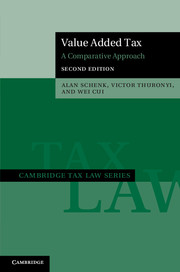Book contents
- Frontmatter
- Dedication
- Contents
- List of Tables and Charts
- List of Cases
- Preface to the Second Edition
- 1 Introduction
- 2 Consumption Tax Forms and Base Alterations
- 3 Varieties of VAT in Use
- 4 Registration, Taxpayer, and Taxable Activity
- 5 Taxable Supplies and Tax Invoices
- 6 The Tax Credit Mechanism
- 7 Introduction to Cross-Border Aspects of VAT
- 8 Timing and Valuation Rules
- 9 Zero-Rating, Exemptions, and Exempt Entities
- 10 VAT Evasion and Avoidance
- 11 Gambling and Financial Services (Other than Insurance)
- 12 Insurance
- 13 Real Property
- 14 An Anatomy of the Chinese VAT
- 15 Interjurisdictional Aspects
- Appendix VATs Worldwide
- Index
- References
7 - Introduction to Cross-Border Aspects of VAT
Published online by Cambridge University Press: 05 February 2015
- Frontmatter
- Dedication
- Contents
- List of Tables and Charts
- List of Cases
- Preface to the Second Edition
- 1 Introduction
- 2 Consumption Tax Forms and Base Alterations
- 3 Varieties of VAT in Use
- 4 Registration, Taxpayer, and Taxable Activity
- 5 Taxable Supplies and Tax Invoices
- 6 The Tax Credit Mechanism
- 7 Introduction to Cross-Border Aspects of VAT
- 8 Timing and Valuation Rules
- 9 Zero-Rating, Exemptions, and Exempt Entities
- 10 VAT Evasion and Avoidance
- 11 Gambling and Financial Services (Other than Insurance)
- 12 Insurance
- 13 Real Property
- 14 An Anatomy of the Chinese VAT
- 15 Interjurisdictional Aspects
- Appendix VATs Worldwide
- Index
- References
Summary
Introduction to International Trade
For most countries with VATs, international trade is a significant component of their economies. A country with a VAT must define the jurisdictional reach of the tax. Should the tax reach global supplies or should it be limited to supplies within the country’s territory? Whether global or territorial, should the tax be imposed on production within the country (an origin principle VAT), on domestic consumption (a destination principle VAT), or some combination of the two? Almost every country with a VAT imposes a territorial VAT that relies on the destination principle to define the jurisdictional limits of the tax. Under a pure destination principle, imports are taxed and exports are completely free of tax (zero-rated). With this system, it is important to identify the value of goods and services that are exported (and when they are exported) and identify the value of taxable imports and determine when they are taxable. This chapter discusses the rules that determine where a supply takes place, including the troublesome issues on cross-border transactions relating to the place where services are rendered and intangibles are supplied.
The location or place of the supply of cross-border services has become more significant with the advent of electronically supplied services. If the place of supply rules applicable to the sale of goods and those applicable to the sale of services differ, the supplier must determine whether the sale is of goods or services, and this may be more difficult in the case of electronic commerce. For example, if computer software, music, and videos are transmitted by electronic signals rather than in compact disks or other physical form, is the transaction a sale of goods or a sale of services? Sales of standard packaged software have been treated as sales of goods, but sales of customized software have been treated as sales of services.
- Type
- Chapter
- Information
- Value Added TaxA Comparative Approach, pp. 187 - 225Publisher: Cambridge University PressPrint publication year: 2015



